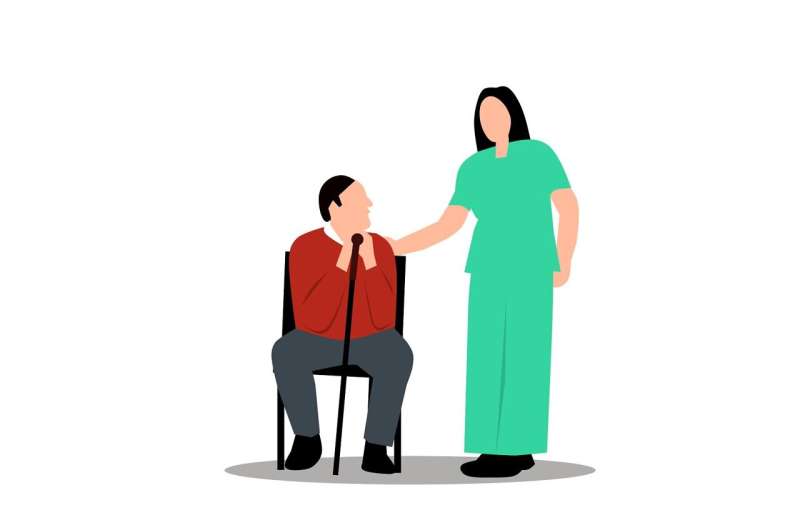This article has been reviewed according to Science X's editorial process and policies. Editors have highlighted the following attributes while ensuring the content's credibility:
fact-checked
trusted source
proofread
Peripheral nerve blocks in total joint arthroplasty beneficial for older patients with fewer comorbidities

In a study conducted at Hospital for Special Surgery (HSS), researchers found that the use of peripheral nerve blocks in total knee and total hip arthroplasty were associated with a consistent reduction in risk for postoperative complications in patients with a lower comorbidity burden. In particular, the most consistent reduction in risk of complications and use of hospital resources was in older patients with no comorbidity burden. These findings were presented at the 2023 Spring American Society of Regional Anesthesia and Pain Medicine Annual Meeting and were acknowledged as one of the President's Choice Abstracts.
"The utility of interventions in a general population of patients might be difficult to show, but might differ by subgroups, with certain patients deriving benefit when others do not," said Stavros G. Memtsoudis, MD, Ph.D. MBA FCCP, an anesthesiologist at HSS and lead author of the study. "In this study, we tried to identify which subgroups might benefit most from peripheral nerve blocks in terms of a reduction in complications after joint arthroplasty."
These findings demonstrate that comorbidities may be a factor with a greater effect on complication risk than other factors, such as age, and that peripheral nerve blocks alone may not be sufficient to consistently influence outcomes in patients with comorbidities.
These findings may also demonstrate that there may be a specific optimal baseline patient population for whom peripheral nerve blocks have the greatest impact on improving surgical outcomes: patients who are older but do not have many comorbidities. This study could help clinicians determine which surgical patients may benefit most from peripheral nerve blocks and which candidates may need additional measures to improve their outcomes.
Many total joint arthroplasty (TJA) patients are at risk for poorly controlled pain and complications. The number of these surgeries performed increases each year, underscoring the importance of finding solutions. To find out how uniformly peripheral nerve blocks can improve perioperative outcomes and pain relief in TJA patients, the researchers conducted a population-based analysis using data from TJA surgeries in the United States from January 2006 to December 2019.
Patients were divided into nine groups based on age and number of comorbidities. Age was broken down as follows: Young (Y) = younger than 65 years; Middle (M) = 65 to 75 years; and Old (O) = older than 75 years. Comorbidities were categorized as: no pre-existing comorbidity (Group 1); 1 or 2 comorbidities (Group 2); and 3 or more comorbidities (Group 3). This led to a breakdown of nine groups total: Y1, Y2, Y3, M1, M2, M3, O1, O2, and O3.
The sample included more than 2.8 million TJA cases performed in 887 hospitals. Of those, 15.5% received a peripheral nerve block. The overall rate of peripheral nerve blocks increased from 9.5% in 2006 to 18.9% in 2019. Peripheral nerve blocks were used least often in young patients with more than 3 comorbidities (13.9%) and used most often in middle-aged patients with no comorbidities (16.3%). Peripheral nerve blocks were associated with a significant reduction in the odds of respiratory complication, acute renal failure, delirium, ICU admission, high opioid consumption during hospitalization, and prolonged length of stay.
The results showed reduced odds of respiratory complications for the O1 and Y2 groups, reduced odds of acute renal failure in the Y1, O1, and M2 groups, and reduced odds of delirium in O1. The risk for ICU admission was reduced in those who received peripheral nerve blocks in all ages with no comorbidities, as well as in the Y2 and O2 groups, compared with those who did not receive a peripheral nerve block. Peripheral nerve blocks also reduced the odds of a prolonged length of stay in the Y1, M1, Y2, M2, and Y3 groups. Odds of high opioid use in patients who received a peripheral nerve block versus no peripheral nerve block were significantly reduced in all groups except for Y3 and O3.
"While peripheral nerve blocks might have the advantage of providing superior pain control versus systemic modalities as well as reducing opioid consumption, a reduction in complications might be expected in those without comorbidities," Dr. Memtsoudis said. "However, given that peripheral nerve blocks still provide better pain control and reduce opioid use, all patients should be considered for peripheral nerve blocks."
"Older patients without major comorbidities might represent a subgroup in which the beneficial effects of peripheral nerve blocks are most likely to be expected," he noted. "This might be the case because major comorbidities are a bigger determinant of complications, with peripheral nerve blocks being less likely to be able to exert a substantial effect."
Future research should include further examination of the benefits of peripheral nerve blocks. "Many questions remain unanswered, including quantification of attributable risk reduction of peripheral nerve blocks and which peripheral nerve blocks provide the biggest effect," Dr. Memtsoudis concluded.
More information: Does the impact of peripheral nerve blocks vary by age and comorbidity subgroups? A nationwide, population-based study. epostersonline.com/asraspring2023/node/165



















